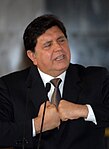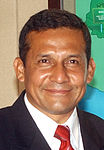Peruvian presidential election, 2006
|
|
||||||||||||||||||||
|---|---|---|---|---|---|---|---|---|---|---|---|---|---|---|---|---|---|---|---|---|
|
||||||||||||||||||||
|
||||||||||||||||||||

Geographic distribution of Second Round votes, by winning candidate.
|
||||||||||||||||||||
|
||||||||||||||||||||
The first round of the 2006 Peruvian national election was held on April 9, 2006 to elect the President of the Republic, two Vice-Presidents, 120 Members of Congress, and five Peruvian members of the Andean Parliament (plus 10 substitutes), for the 2006-2011 period.
No single presidential ticket obtained more than half of the total valid votes thus leading to a runoff election held on June 4, 2006 between the two candidates with most votes, Ollanta Humala and Alan García. Garcia won the election with 52.62% to Humala's 47.37% making Garcia the President-elect of Peru. The president-elect was inaugurated on 28 July 2006, on Peruvian National Day.
The Congressional election made use of 25 Electoral Districts (Peru's 24 departments and the Constitutional Province of Callao). The number of seats in Congress for each district was determined by its number of eligible voters. A political party need to win a minimum of five seats in two electoral districts or 4% of nationwide valid votes in order to be represented in Congress.
Like the presidential and vice-presidential election, the Andean Parliament election did not use Electoral Districts, using nationwide votes instead. A minimum of 4% of nationwide valid votes was necessary for a party to get any representation in the Andean Parliament.
"Valid votes" only include votes correctly issued for exactly one candidate. Hence, blank ballots, multiple-candidate votes or incorrect markings did not affect the overall results, functioning at most as political statements.
The National Registry of Identification and Civil Status (Registro Nacional de Identificación y Estado Civil, RENIEC) was in charge of registering eligible voters; the National Office of Electoral Processes (Oficina Nacional de Procesos Electorales, ONPE) organized the election; and the National Jury of Elections (Jurado Nacional de Elecciones, JNE) made any rulings concerning the election, including the proclamation of official results.
...
Wikipedia


